
When you hear the term international SEO, what do you think of?
A common answer is translating content into multiple languages and using the hreflang attribute.
You wouldn’t be wrong, but there’s a lot more to it than that.
In this guide, I will dive deeper into what international SEO is, how to use it to get ahead of the competition, and how you can build it into your strategy step by step.
There’s a lot to sink our teeth into so let’s get started!
What is international SEO?
So first things first, let’s identify precisely what international SEO is.
Put simply, it’s a way to manage multiregional and multilingual sites, so search engines know which version to rank and send users to.
What’s the difference between the two site types, you ask?
Multiregional sites - a website optimized for audiences in different regions.
Multilingual sites - a website optimized for different languages.
What is important to realize early on is that your role is much more than just implementing hreflang. It’s also about strategizing and helping to make a business case for localization.
Several tools and processes will help you implement a winning international SEO strategy:
Google Analytics location/language reports
Localized keyword research
Competitor research
Hreflang
Google Search Console International Targeting
ccTLDs
Localized site structures
Human-translated content and localized pages
We’ll explore each of the following in more detail throughout this guide.
Why is international SEO important?
The ultimate goal of international SEO is to improve user experience by ensuring the user has an effortless journey from search engine to website.
A well-implemented international SEO strategy prevents roadblocks, such as:
Users landing on the wrong country/language variation of a site
Missed opportunities for localized content
It’s all about ensuring your site meets your audience’s expectations in whatever region they are in and avoiding lost opportunities.
Implementing an international SEO strategy
Now you know how beneficial international SEO could be, let’s look at the five steps to get you there.
1. Will international SEO be beneficial?
If your traffic all comes from one location and you have no intention of broadening that, then international SEO will likely not be beneficial.
However, suppose your business operates in multiple regions or is open to expanding into a new territory.
In that case, you need to start doing some research to determine your strategy.
Use the Google Analytics location report.
A great place to start is using the Google Analytics location and language reports located in Audience > Geo > Language to see if you get traffic from regions you aren’t targeting with localized content.
The map is an excellent option for those who prefer visual aids. It shows the locations where you are getting the most visits from and the areas where you are getting minimal traffic.
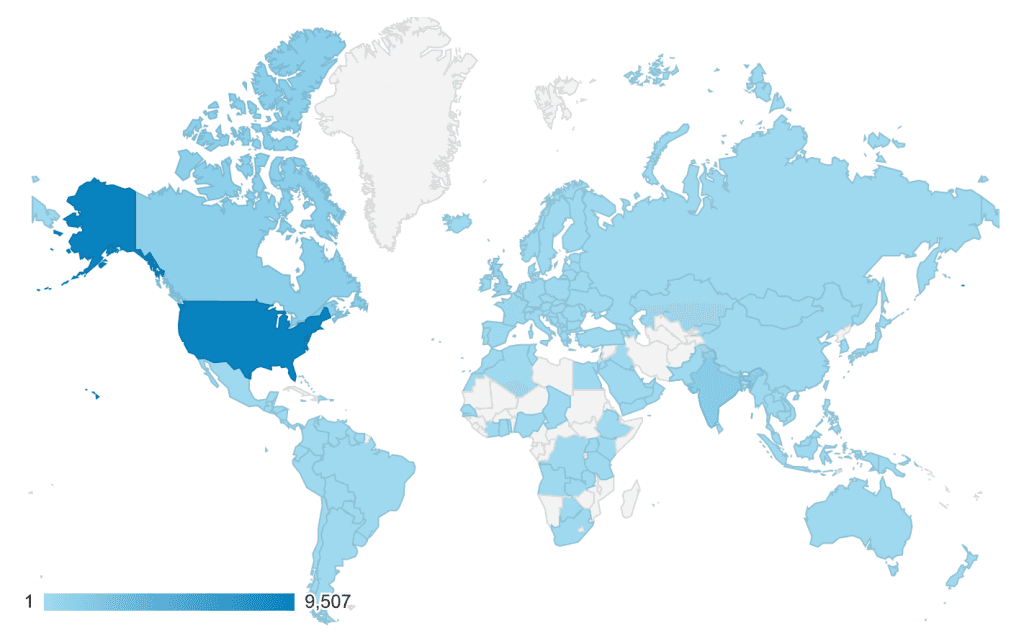
If you click on a country, you can see which regions in that country are sending the most visits.
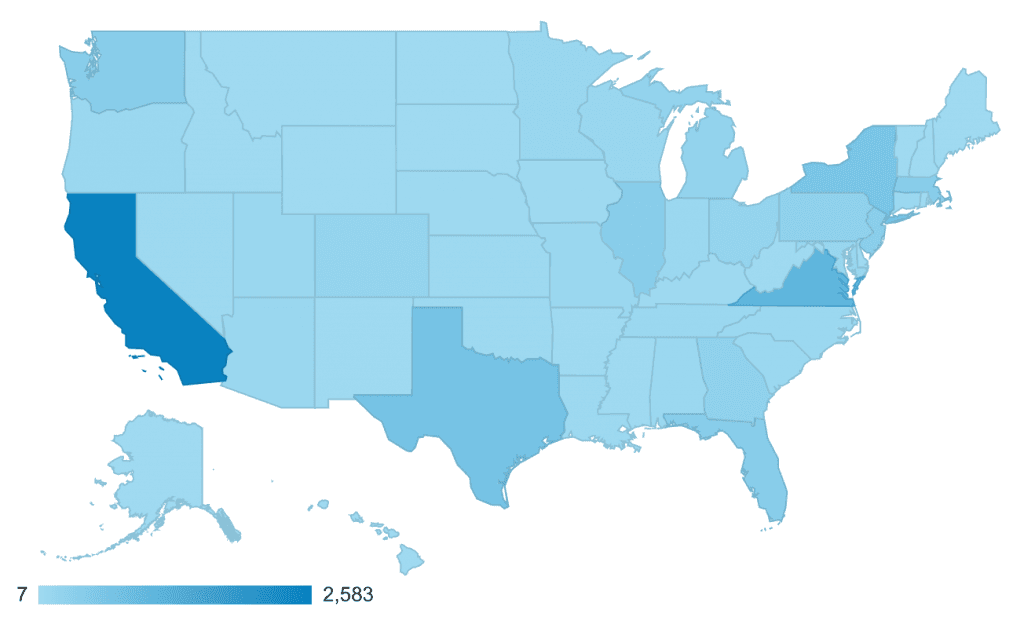
The map is best used to identify the regions that send the most and least traffic; it can be harder to differentiate regions in the middle.
Google Analytics location report table
The location table just below the map shows the same information, but with more detail.

The report table makes it easier to compare performance across multiple locations. It will also give you direction on where next to focus your efforts.
For example, if you spot a lot of traffic from a specific location where you’re not currently selling, it might be time to think about how you can begin to open up your services there.
Google Analytics language reports
Also review the language report, which shows the ISO code used in your visitors' browsers.

You’ll notice that languages are split out by both region and language. For example, you may see both ‘en-gb’ and ‘en-us’.
To see total traffic for a language variation, use the filter box above the table to search for a language.
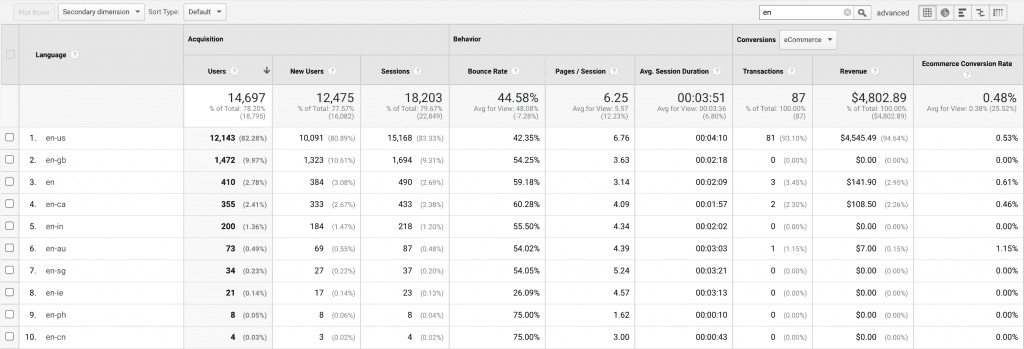
This allows you to quickly spot the total traffic for a language, showing the number of users who could benefit from localized content.
Sistrix
You can also use tools like Sistrix to monitor SEO visibility in different regions.
This can give you an indication of whether users may benefit from a localized site if one doesn’t exist yet.
Put your website into the toolbar and head to the ‘Countries’ report in the left sidebar’s ‘Structure’ area.

The report returns visibility by country; as you can see for this UK-only site that ships to multiple locations, it may be worth considering a localized site for Spain, Ireland, and the US.
Ahrefs
Ahrefs is another tool that helps identify opportunities in different locations.
Within the ‘Site Explorer’, if you go to the ‘Organic search’ tab, you get an excellent overview of estimated traffic and ranking keywords by country.
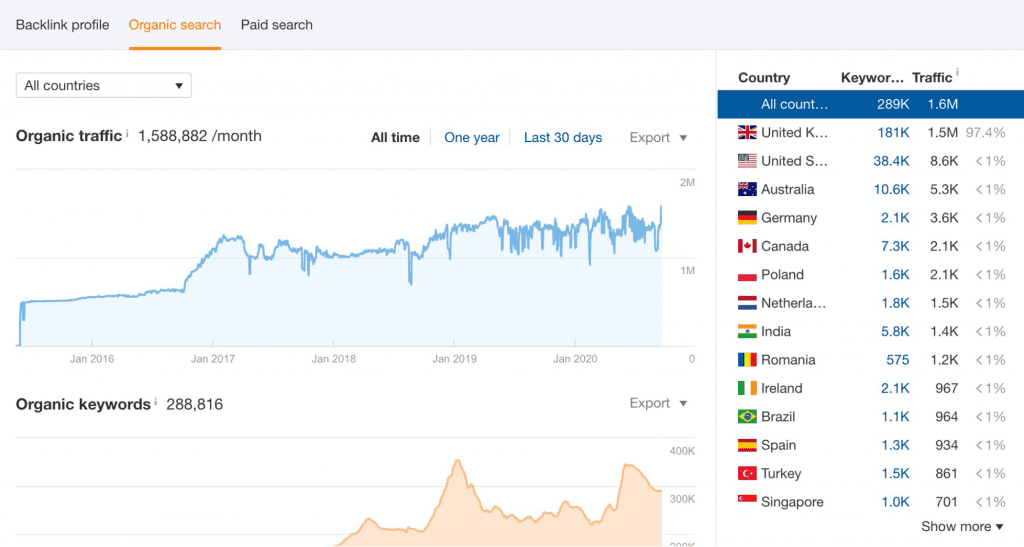
Again, you can quickly see for this UK based site that ships internationally that they could benefit from localizing in quite a few countries.
Once you’ve played around with some tools and have potential target locations, it’s time to understand the market opportunities further.
How competitive is the market?
It’s worth getting to know how your competitors in these ‘new’ locations differ from your current ones.
The best way to do this is by performing a quick top-level competitor analysis.
You want to look at things like:
How much traffic does each site have?
Are there any differences in product offerings?
How much authority do the sites have? Are authority metrics higher than what is found in your current market?
Are competitors localizing content for this region?
Is the keyword difficulty greater or lower to rank?
There are multiple tools you can use to do this analysis quickly, such as:
SimilarWeb - useful for checking top channels that drive competitors traffic
Ahrefs - Domain authority comparisons as well as traffic levels
Moz - Domain authority comparisons
Sistrix - Visibility history of the domains as well as link-based metrics sourced from Majestic SEO
Perform quick localized keyword research
I recommend localized keyword research on some of the top terms within a location to measure traffic potential.
This can be kept top-level, but I tend to make some quick comparisons of the top keywords in your current region and what the volumes look like in the new location you are investigating.
For example, say we’re selling birthday cards in the US, and we’re investigating opening up a branch in Germany.
Use something like Ahrefs Keyword Explorer to check search volumes for terms in the US.
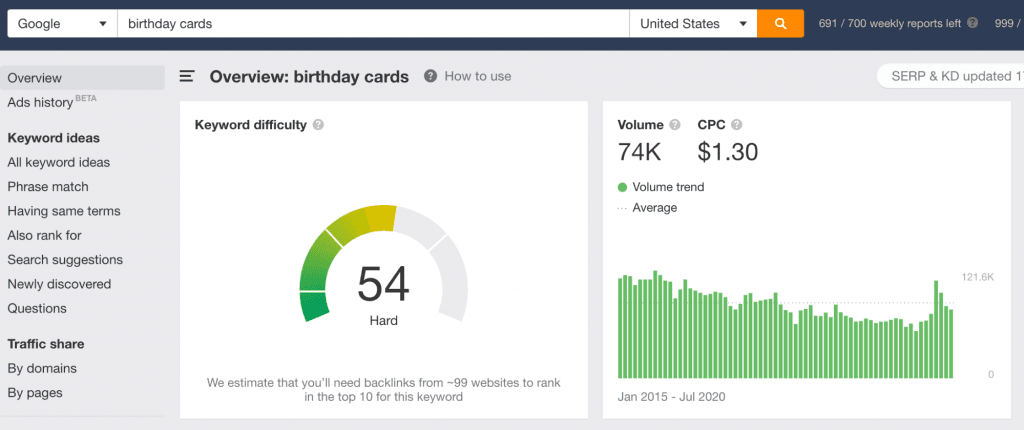
And then compare that to Germany.
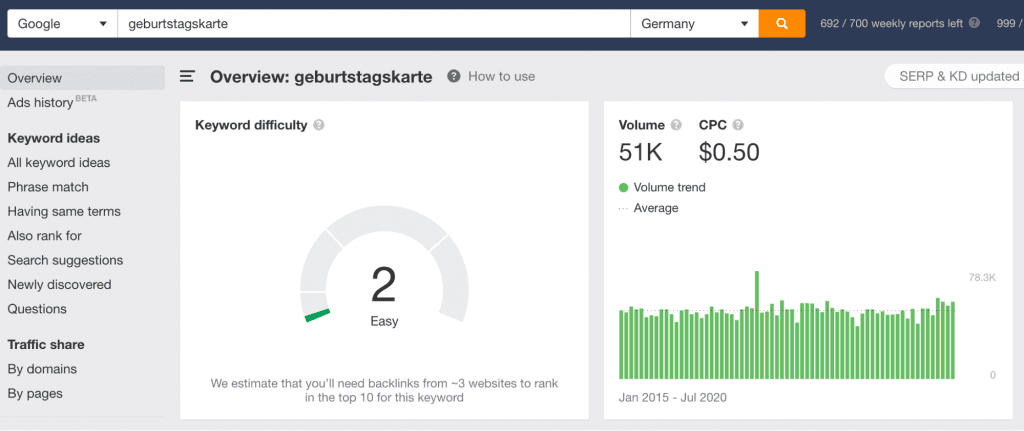
Make a note of both keyword difficulty and the difference in volume.
After you’ve done this with a handful of high potential keywords, you can gather a rough estimate of the percentage difference in demand between countries for the top terms.
At this point, I would also recommend checking the trend for different keywords in that region in Google Trends to be sure you're not recommending a region with demand that is drastically declining over time.
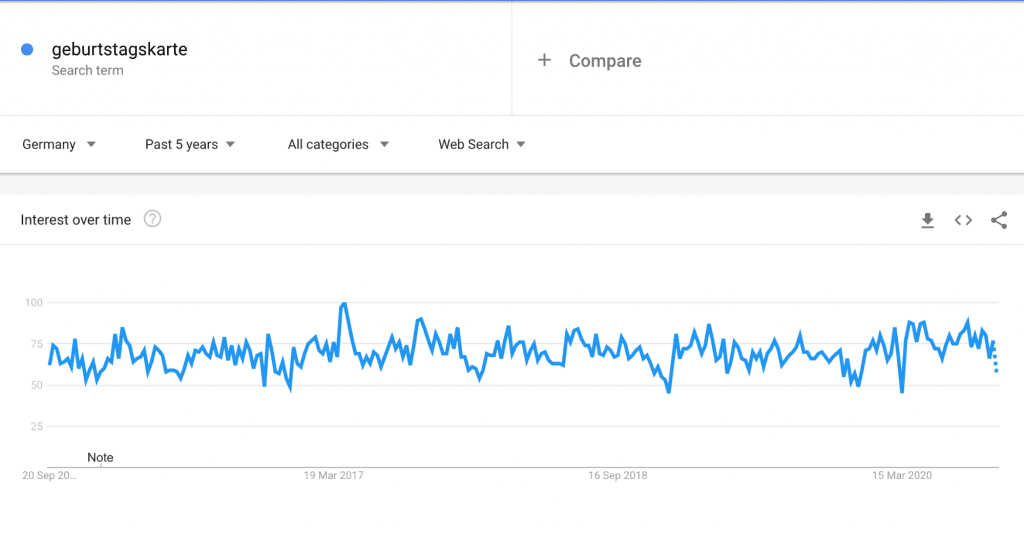
2. Consider audience behaviors and your goals.
The main barrier you’ll come across is language.
If localized language would benefit your audience, then I’d strongly recommend you create a multilingual site.
However, many countries do speak the English language, making translating less of a requirement.
Some of the top nonnative English speaking countries include:
Luxembourg
Finland
Norway
Denmark
Sweden
Netherlands
Singapore
One question to consider is, ‘are users going to convert better on sites localized to their country?’. If the answer is yes, then I’d recommend creating a multilingual site.
Now answer a couple more questions:
Does pricing need localizing? If you’re a customer in France, you’ll want to see prices in Euros and not dollars.
Are there customs in that country that need catering to?
If the answer to both is yes, you should consider both multiregion and multilingual sites.
Now you’ve identified a need for a multiregion or multilingual site; it’s time to build a strong business case for both the benefits and why you should do it.
Some things to include in your business case are:
Potential audience location opportunity
Ultimately, this is what propels your business case.
The point of optimizing for international SEO is to reach a potential audience in locations outside of where your efforts currently lay.
If you reach a wider audience and optimize appropriately so their needs are met, it will mean more conversions.
How this audience is finding your business
This changes from location to location. Don’t just assume the world uses Google, because, in many countries, they have a different preferred search engine.
In China, their search engine of choice is Baidu, and this is the third most prominent search engine worldwide. Again, if you’re expanding into this market, this is something to know.
Other popular search engines you might not be familiar with are:
Yandex - the leading international search engine in Russia and surrounding countries.
Naver - the leading international search engine in South Korea.
Competitor research
You should already have this included in your current SEO strategy, but new competitors will pop into the scene if you’re targeting different locations.
I’d recommend following the advice in my SEO competitor analysis guide as far as things to consider.
When you’re expanding into different markets, you need to think outside of SEO. Some things to consider are:
What brand marketing strategies are they using?
What content marketing are they doing?
Are they using paid advertising?
What channels drive traffic for competitors?
These things have an indirect impact on how well your international SEO strategy will do, so it’s good to do a top-level analysis to figure out potential opportunities or risks.
3. Develop an internationally targeted site
Let’s say you’ve won your business case, and it’s time to jump into international SEO.
The first consideration is all-around technical implementation, so let’s start there.
Consider the domain structure.
A good URL structure doesn’t just look appealing. It builds trust with your audience.
There are multiple options for URL structure, and which one you go with will depend a lot on what is technically possible with your site.
ccTLDs
First, there is country code top-level-domains, otherwise known as ccTLDs.
An example ccTLD would be ‘domain.fr’.
Some benefits to using ccTLDs include:
Securing your business name is that country
Building trust with the audience in that location
Strong signal to search engines as to which country the site is targeting
With benefits come cons, these include:
Separate domains can dilute domain authority between sites
Hard to manage and organize
Subfolders
Subfolders are another option.
You keep your domain name, using a global top-level domain (gTLD) like a .com, and then put the country/language combination in a subfolder www.domain.com/fr/. If you want an example, take a look on the Apple site.
Benefits include:
Easy to maintain
No cross-domain considerations for tracking
Keep existing domain authority
The cons include:
The audience may prefer a local site
Weak signal to search engines as to which country the site is targeting
Subdomains with gTLD
You could also decide to go with a subdomain with a gTLD. An example of one of these would be ‘fr.domain.com’.
Benefits include:
Easy to manage and organize
The cons include:
Domain authority may not be passed as it is technically a different domain.
There is also the option to create a combination of some of the above.
It can take a minute to get your head around all of the varieties and the possibilities. But before you start and make your decision, first make sure to work with the dev team to figure out what is possible.
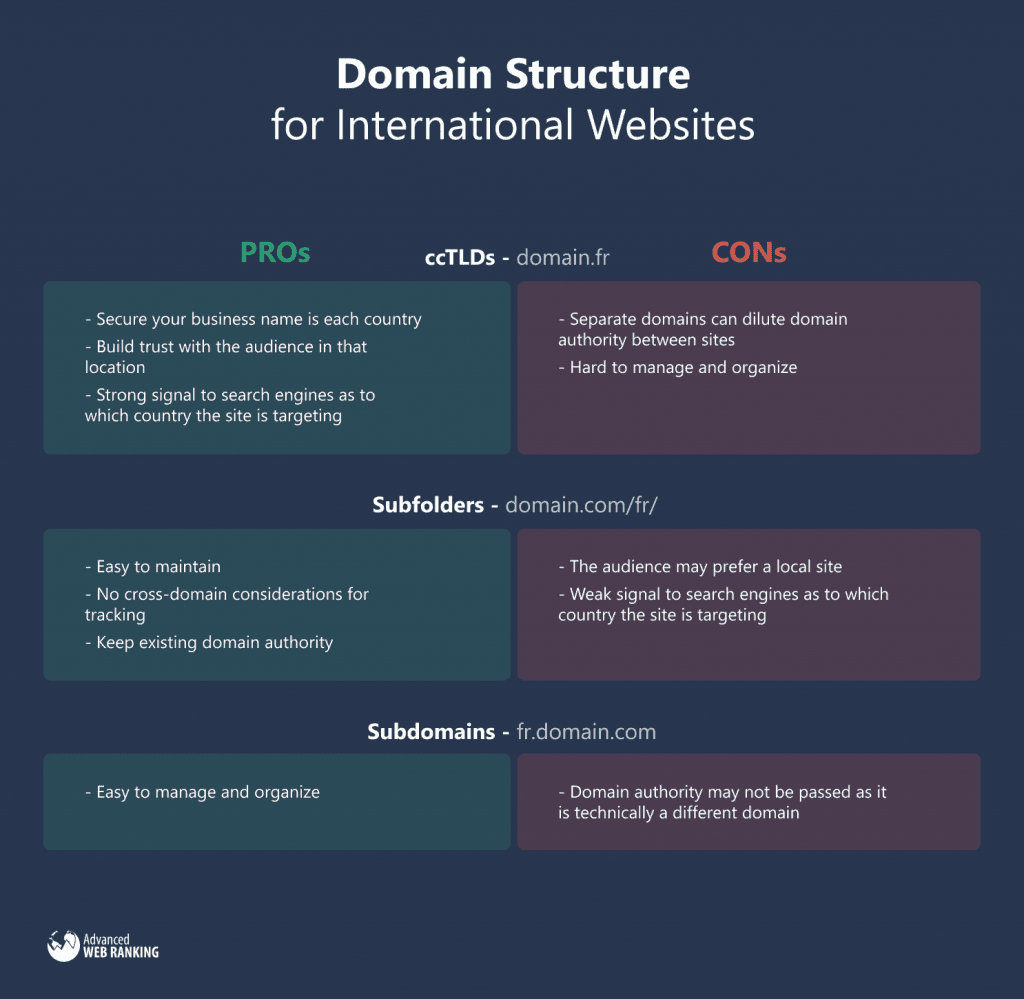
Perform detailed keyword research and develop individual structures
Earlier on, I mentioned performing some quick keyword research to identify whether there was an opportunity to be had in each location.
Now it’s time to perform some detailed keyword research. The keyword set could vary depending on location, so make sure you run keyword research for each location you are targeting.
It’s crucial to develop individual site structures and navigations based on your keyword research.
Some things might be popular in one location and not so much in another.
For example, on a fashion site, coats might not be relevant for someone in Australia, but they would be for someone in Sweden.
Use Google Search Console International Targeting
Next, in the Google Search Console International Targeting report, you can select which country a registered property targets.

This is currently only within the old Google Search Console, and also note that this doesn’t allow language targeting.
Create unique localized content - don’t machine translate - I can’t stress this enough!
Machine translations are known for not always being accurate, and context can go out of the window.
Instead, try to partner with someone fluent in the language and begin translating.
Not only will the content make sense, but it can also include localized slang and incorporate your brand's tone of voice when appropriate, making the content something the audience can relate to.
It’s also crucial that you localize every aspect of your website. Don’t just think about the content; you need also need to consider the following:
Headings - these might need to be localized to be relevant to specific audiences. For example, an international realtor should adjust an existing header of ‘How to buy a house in the US’ to ‘how to buy a house’ to make it relatable for different locations.
Imagery - localized content also includes imagery. If a site is selling houses to a French market, images of a street in the US isn’t going to make sense.
Addresses and phone numbers - if possible, it’s worth having a local address and phone number that someone can call if they are having issues.
Localize structured data
Schema is the language behind structured data. Adding structured data markup helps search engines understand information on your site better, including your organization’s addresses, phone numbers, opening hours, and more.
Ensure you localize all of this information and any other relevant structured data while you are creating the site.
Implement hreflang markup
Hreflang markup is vital in letting search engines know the language your content is in and the region it is targeting.
While not always required, it gives a strong and clear signal to Google which site variation to show in search results.
Hreflang markup should include both reference alternate language/country variations of an individual URL and self-reference the current page variation.
It is also essential that hreflang should match the canonical page and should be bidirectional.
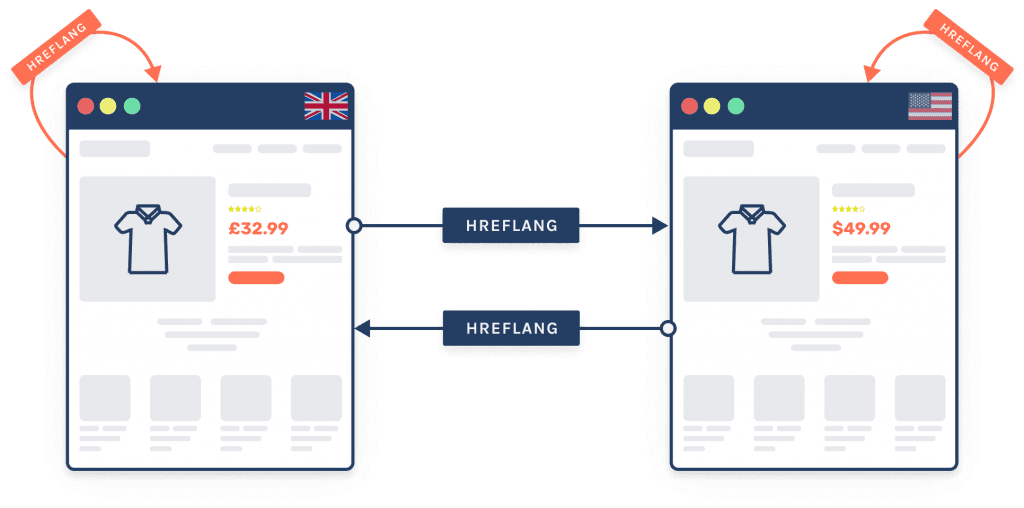
Some places you can add the attribute are:
<head> section of the URL
XML sitemap markup
HTTP headers
You can also optionally implement something called the x-default tag when implementing hreflang.
The URL you pick as your x-default is used as a fallback when no language/country variation is available.
Recommended: Google guidelines on hreflang
Do not auto-redirect users
Auto-redirecting users is not only not a great user experience, but it could also mean that search engines miss crawling content that you want them to see.
For example, Google crawls from the US, so if you keep automatically redirecting Googlebot to your site’s US variation, it could create some issues with country/language variations not being accessible.
Implement non-intrusive interstitial to swap to a relevant site.
This gives the user the option to go onto a site that will provide a better UX for them in a noninvasive way.
You want to base your suggestions on the user’s location to make swapping as efficient as possible.
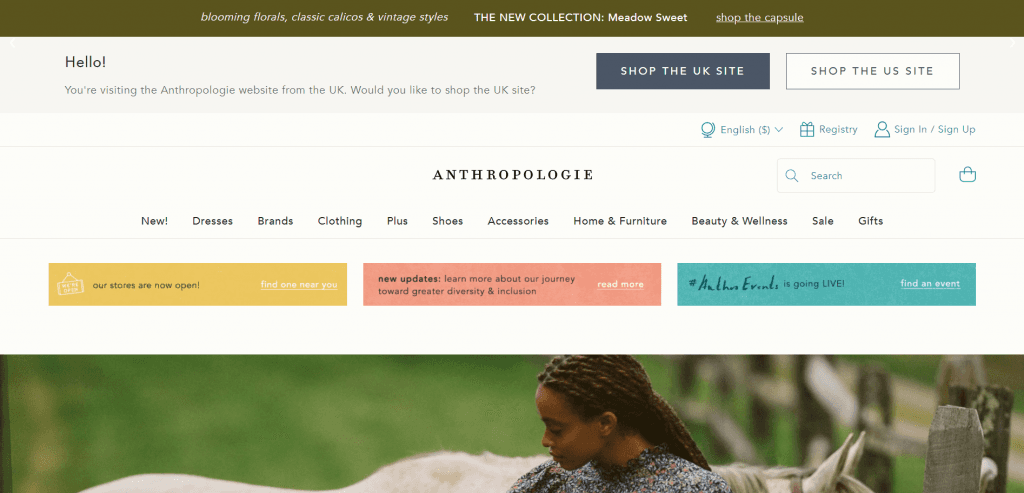
Make an easily switchable internal navigation.
Navigating between your site variations should be as smooth as possible.
To ensure a good UX, add links within a menu to both multilingual and multiregion site variations.
A common pitfall here is when you create a menu that is ideal for Google to crawl to find all site variations and share ranking signals, but it's injected into the page via JavaScript.
Ensure that these links can be found within the page source, making them easily crawlable. Provide the links within an <a> tag, rather than within a <select> drop-down menu.
If you have a large number of countries offered and you can’t include them all within a menu easily, instead consider linking to a country selector page. Again, Apple has a great example of this kind of setup.
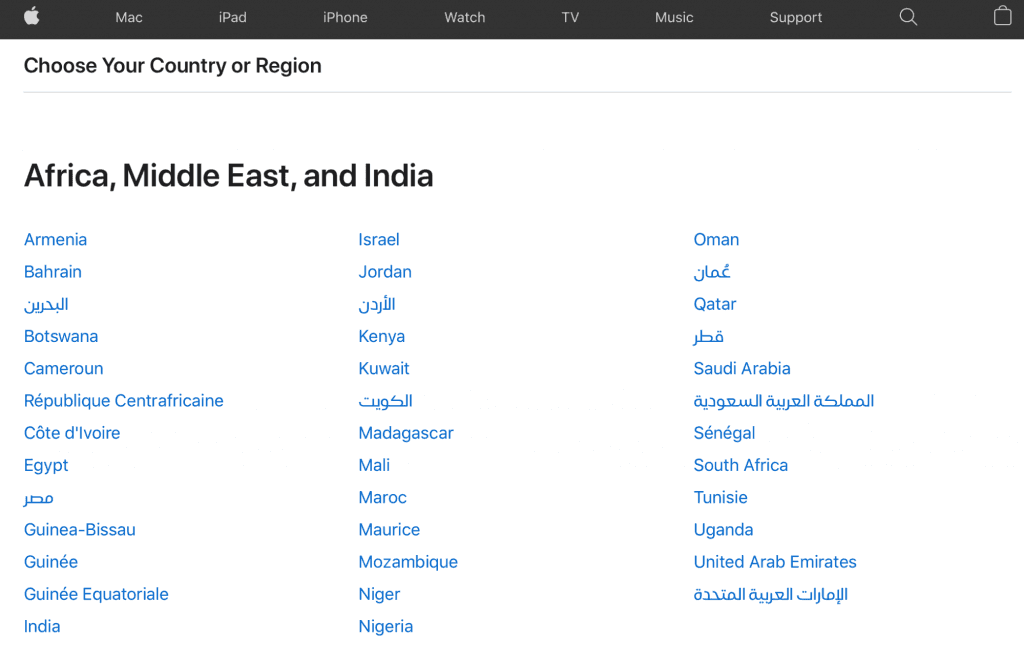
4. Promote your site.
Now you’ve got the technical bits out of the way; it’s time to move on to the fun aspect of promoting your site to your new audience!
If you’re looking to expand in a new location, try doing it with a big bang, it can help you kick-start your site and quickly gain some links. Consider:
Digital PR campaigns
TV campaigns
Social campaigns
I’d also recommend putting in some leg work with manual outreach.
Start creating a localized link building strategy for each market.
Unfortunately, it’s not a one tactic fits all process. You’ll likely find that in different markets, different tactics will work.
You should have a good idea of what works based on the competitor analysis you performed earlier.
Once you find a technique that works, run with it!
5. Measure the entire process.
Now you’ve put in the time and effort to expand audience reach; it’s time to keep track and see how that hard work has paid off.
Track rankings for each location
It’d be remiss not to mention this is somewhere Advanced Web Ranking excels.
Set projects up to target the country you’ve rolled out your new international sites in.
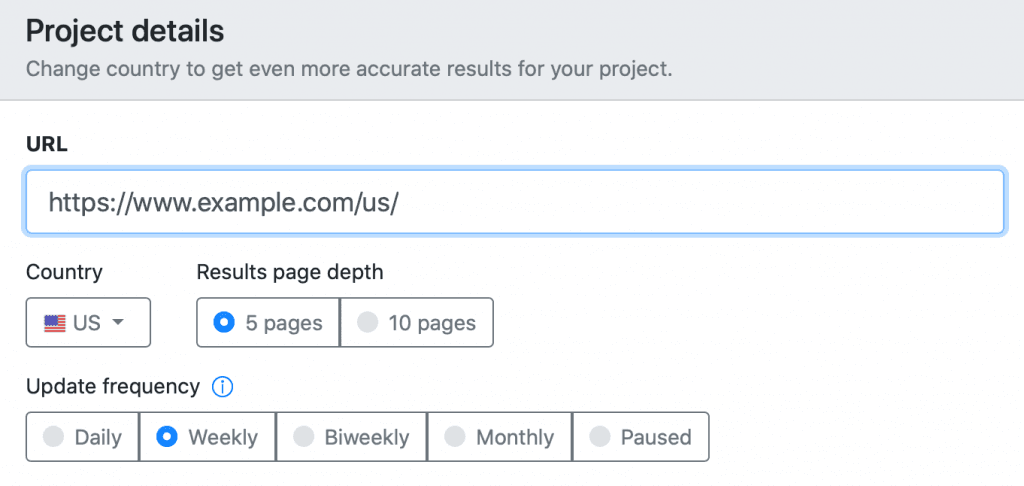
Import CSVs of your keyword research into nicely grouped lists.
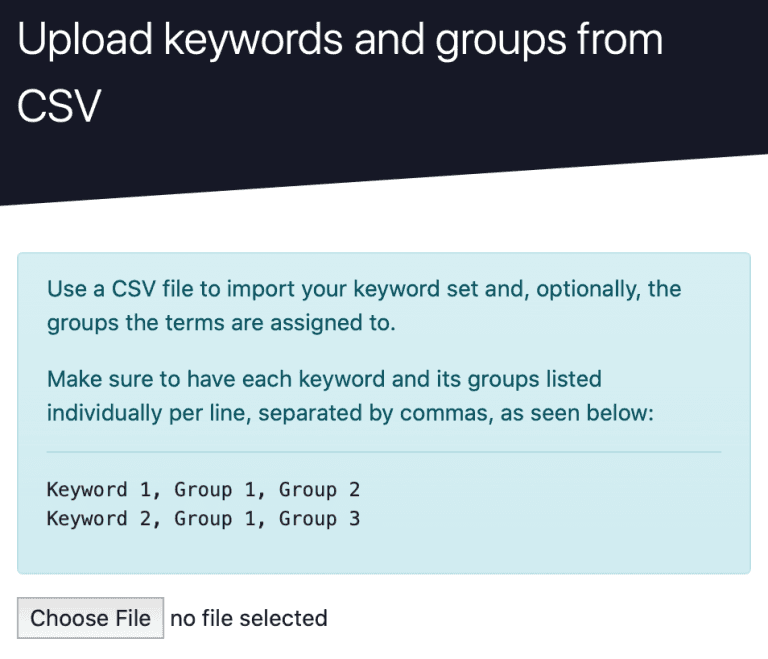
And track within a variety of search engines, including Google, Yandex, Baidu, Bing, and many more:
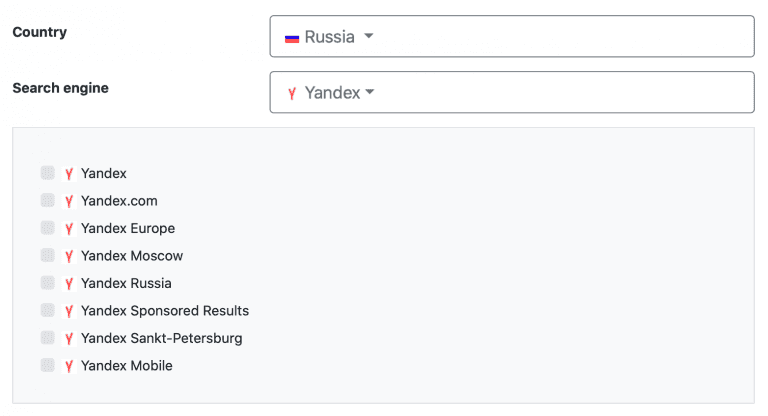
Use Google Search Console
You’ll also want to set up Google Search Console properties for each site.
Unless you’re using ccTLDs, you’ll want to set up a mixture of a domain property collecting data for all site variations and URL prefixes for individual variations.
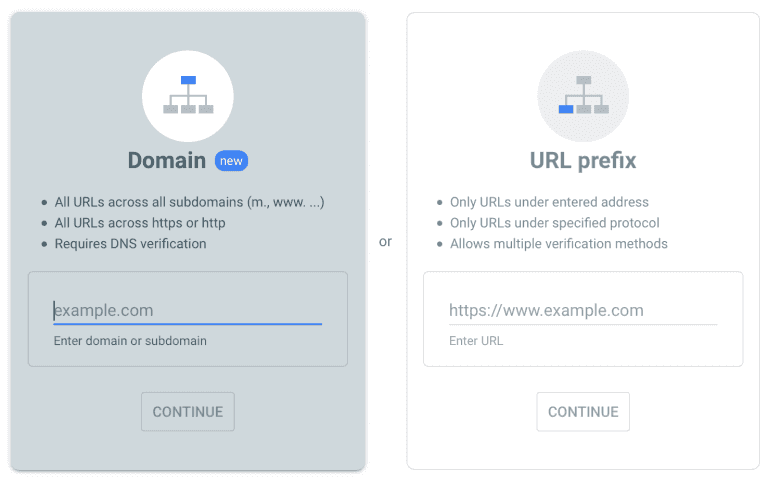
Once set up, you can also make use of the GSC International Targeting reporting on hreflang errors.
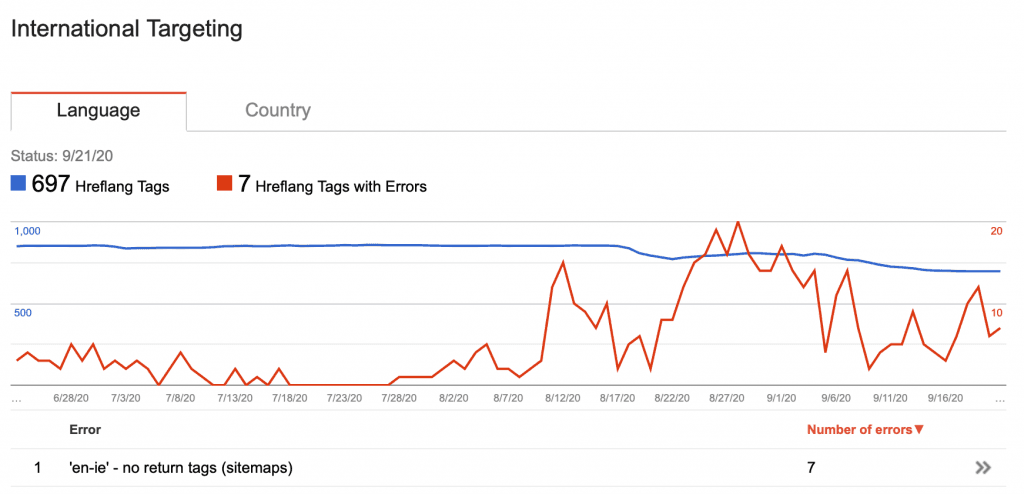
Set up individual Google Analytics views
Finally, you’ll want to set up Google Analytics views for each site variation.
I’d recommend you keep one property and then use filters on views to collect data for different languages and locations individually.
How you do this depends on setup; if you’re using subfolders, it’s as simple as configuring filters based upon Request URI.
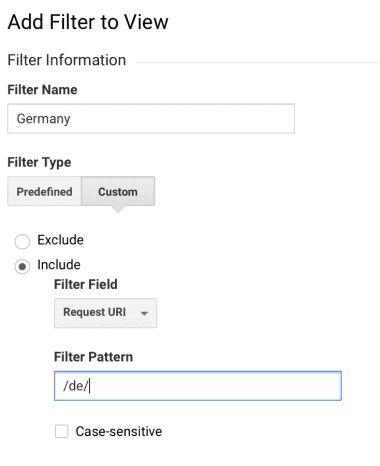
If you’re using subdomains or ccTLDs, do this based upon hostname.
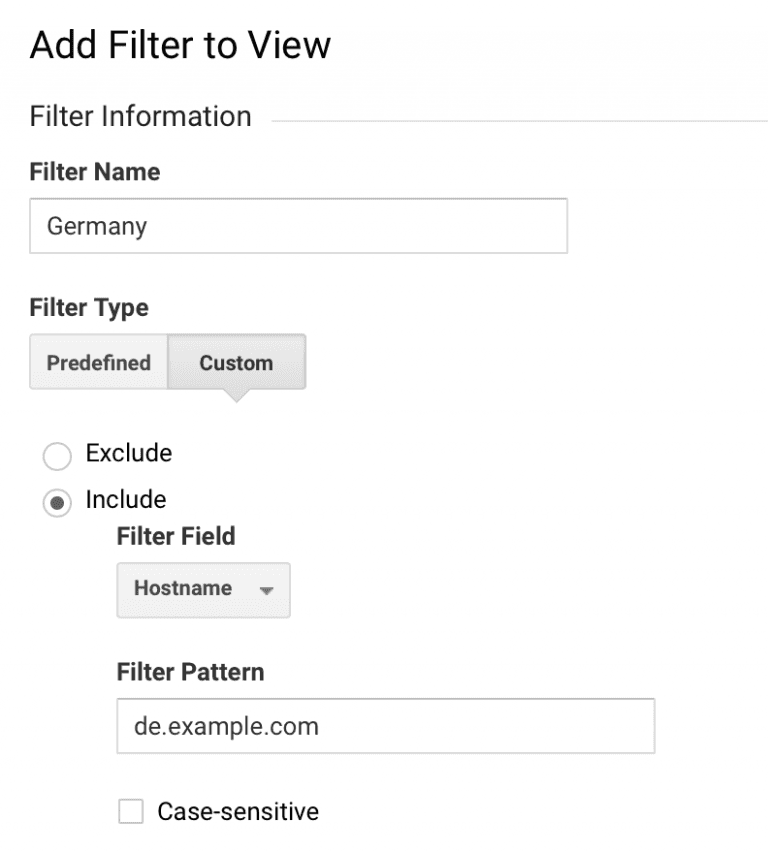
In more elaborate setups, you may even want to use custom dimensions mixed with a dataLayer.
Wrapping up
Optimizing your site for an international audience is not a simple process, but if you follow my five steps, you can target, localize, and grow your audience internationally.


